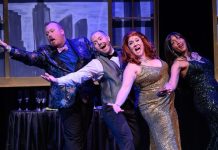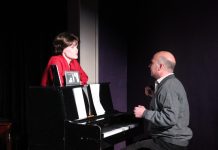It’s a busy midsummer for Midsummer. In addition to the current production by The Arlington Players, two other takes on the ever-popular Shakespeare comedy go up this month, at the Folger Theater, staged at the National Building Museum, and at Synetic Theater, in one of their trademark nonverbal adaptations.
The Arlington Players production is also billed as an adaptation, attributed to director Erin Branigan and Katie Rey Bogdan. Branigan sets the action in the 1920s. “Magic exists,” Branigan’s program note proclaims, citing no less an authority than the lady bountiful of my home area of Boonsboro/Keedysville, Maryland, romance novel legend Nora Roberts. Branigan hopes that the audience will “find some everyday magic in our play.”
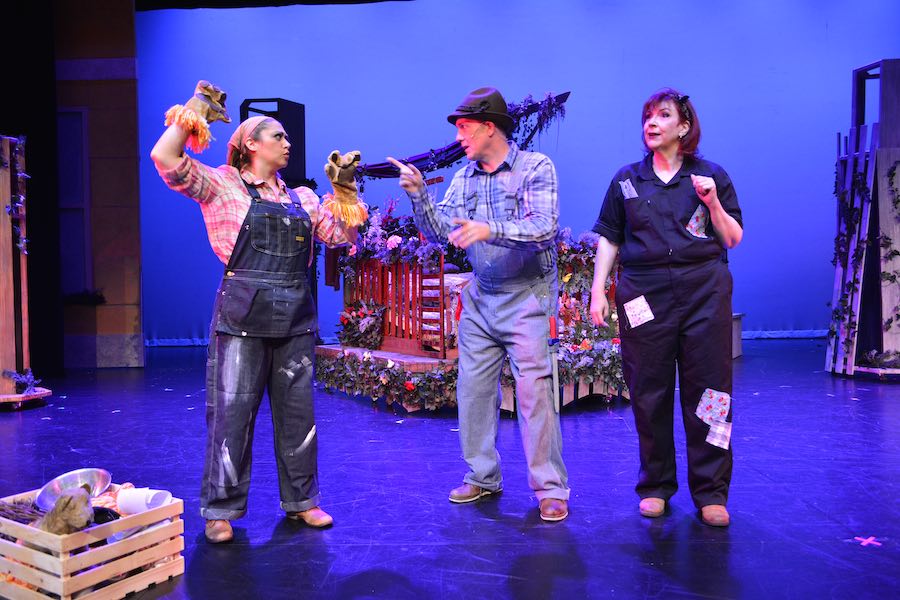
The 1920s setting goes only so far. Duke Theseus (an elegant Nick Temple, in the play’s standout acting performance) and his fiancée, Hippolyta (Becki Turner), are dressed and play their roles as people who would fit in comfortably at one of Jay Gatsby’s parties. Otherwise, with some exceptions in Anna Marquardt’s colorful and highly eclectic costume designs (e.g., the gray and white pajama-like outfits worn by one of the young couples in the final scene, some of the mechanicals’ outfits), the 1920s theme appears only fitfully. Bottom’s wearing a U.S. Army dress green staff sergeant’s jacket as Pyramus was a particular curiosity.
The adaptation does a gender switch among the play’s young lovers. Shakespeare’s Hermina becomes Herminus (Alex Lew). Helena becomes Helenus (Mike Kelly). Lysander becomes Lysandra (Naomi Park), and Demetrius becomes Demetria (Emma Wesslund). Egeus, Hermina’s meddlesome father, becomes Herminus’ meddlesome mother (Judy Lewis in a nice comic cameo, complete with swigging from a bottle of something alcoholic as the lovers celebrate near show’s end).
Gender ambiguity having always been a strong subtext of Midsummer and part of its lasting charm, the adapters’ choice is a perfectly valid one. But it appeared to me to have little in the way of consequences for the progress or meaning of the story in the Arlington Players production. Far more prominent was Branigan’s decision to adopt a style for the lovers’ scenes on the broad comedy edge of rom-com performance. Kelly and Wesslund pull off the style with excellent physical presence and energy, while Lew goes for an awkward nerd persona for Herminus.
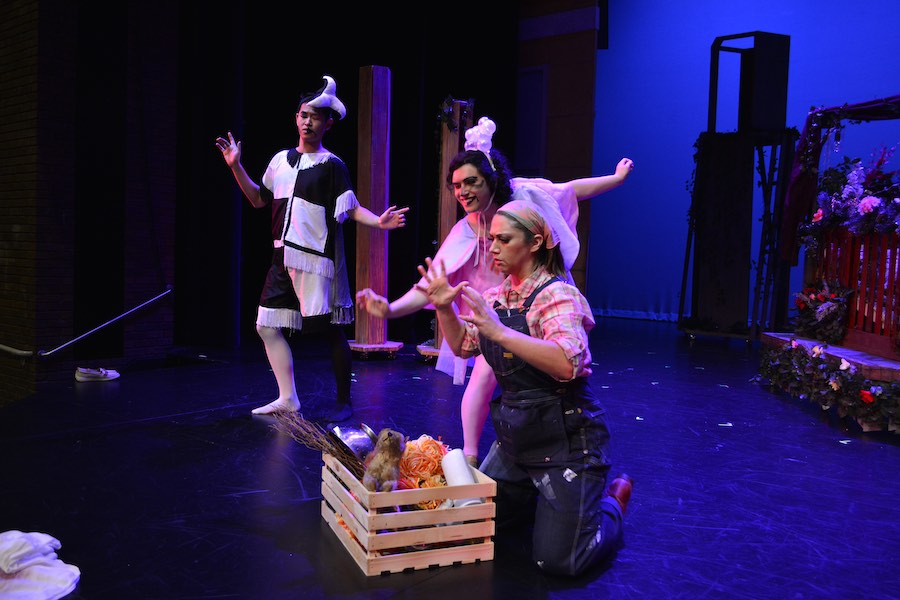
Shakespeare’s ground for the quarrel between the fairy royals, Titania (Kimberly James) and Oberon (Alden Michaels) — it concerns who gets control of an exotic child — has always seemed a thin plot device. Watching this production, like virtually all I have ever seen, I yearned for actors and directors to find something meatier in terms of the emotional dynamic between the two to explain their relationship issues. Regardless, their disagreement is necessary to motivate Oberon’s use of Puck (Apollo Yong) to set about manipulating other characters’ lives.
In Shakespeare’s text, Puck is simply identified as a fairy. Here, he is labeled Oberon’s “jester,” and in his costume of opposite black and white segments (which carry through to his makeup), he looks the part. He is, in any case, a trickster, though a less than fully competent one, whose mistakes lead to a series of comic complications. Magic may exist, but sometimes it misfires.
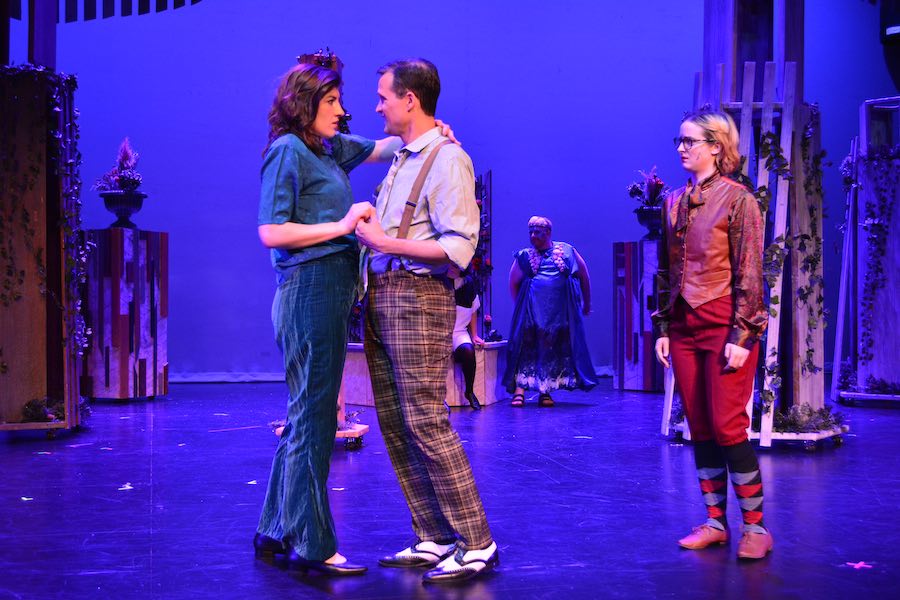
There are as many interpretations of Puck as there are productions of Midsummer. Yong’s interpretation involves a relentless, gyrating whirlwind of activity: arm movements, body bends, running about. There could be more lightness in the character, and even moments of quieter, detached amusement, as Puck contemplates “what fools these mortals be.” Sometimes Puck’s constant physical action covered his lines. Yong also doubled in the function (though not the character name) of Philostrate, the emcee for the Pyramus and Thisbe show, assuming for that purpose a far stiffer and more robotic physicality.
Ben Lowater’s Bottom dominates the mechanicals’ group, and anyone who has attempted to direct an actor who wants to take over a community theater production can empathize with the patient, much put-upon Peter Quince (Steve Rosenthal). Bottom, and the mechanicals generally, are always over the top, as they should be, and when the group presents its adaptation of Pyramus and Thisbe in the final scene, Kate Ives as the Wall and Rachel Fine as the Lion contribute particularly cute bits.
Bottom’s prime piece of business comes when he is transformed into a donkey by Puck’s trickery, which Lowater embellishes with a rendition of Herman’s Hermits’ 1960s cover of the novelty song “Henry the Eighth,” which oddly, but perfectly, fits the mood of the moment. His palpable basking in the attentions of Titania and the fairies is delightful.
Patrick M. Doneghy’s choreography makes extensive use of the large ensemble of fairies in dance breaks attending the scene changes. Like their counterparts in Gilbert and Sullivan’s Iolanthe, the fairies trip hither and thither, amidst much prancing and arm-waving. The fairies execute the concept enthusiastically, but the overall effect, especially given its frequent repetition, is less magical than simply busy.
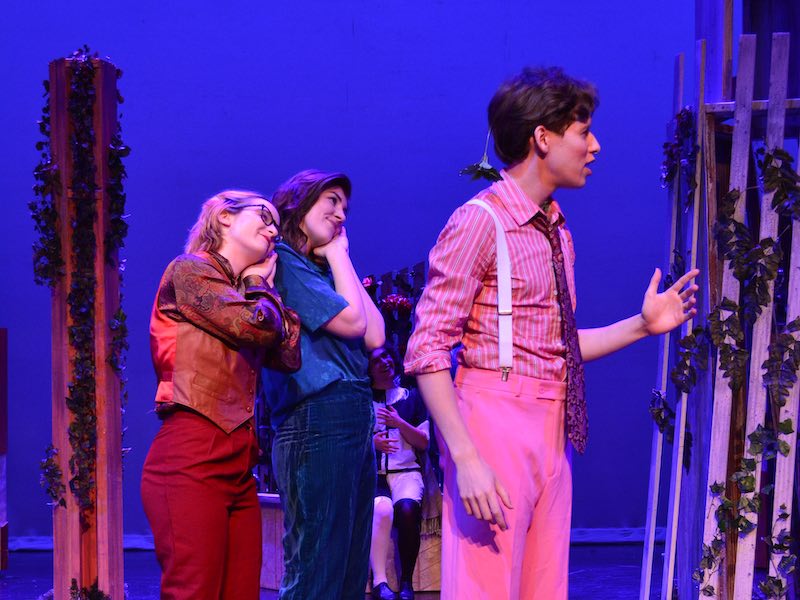
Like other aspects of the production, Neel Madan’s sound design begins in the 1920s, with pre-show period jazz selections. But then the music, composed by Donna Korn, becomes as eclectic as the costuming, influenced by everything from Renaissance to Celtic styles. There were numerous glitches in execution of the mic/sound reinforcement system at the performance I attended, particularly in the first act.
David M. Moretti’s complex set design featured sliding flat panels, flown-in elements, and a variety of wheeled-in units, creating a flexible, visually interesting, space for the actors that was never too heavy or obtrusive. Titania’s bed, complete with flowers and electric fairy lights, was an especially fun piece.
Whether or not Arlington Players’ Midsummer consistently creates magic for its audience, it contains performances and production elements that are energetic and entertaining. And as always with Midsummer, it’s hard to argue with a happy ending for all.
A Midsummer Night’s Dream plays through July 10, 2022, presented by The Arlington Players performing at the Thomas Jefferson Community Theatre, 125 South Old Glebe Road, Arlington VA. Tickets for the remaining performances (July 7–9 at 8 pm and July 10 at 3 pm) are priced at $25 ($22 for seniors and military, $15 for students and children) and are available online. The July 9 performance will be ASL-interpreted. Arlington Players will email detailed parking instructions to people ordering tickets.
The cast, creative, and production credits for A Midsummer Night’s Dream are here.
COVID Safety: Masks are required at all times for all patrons regardless of vaccination status. Proof of full vaccination against COVID-19 or a recent negative COVID-19 test is no longer required to attend performances at The Arlington Players.


